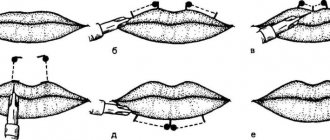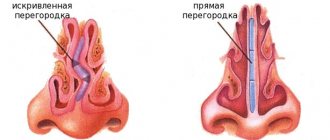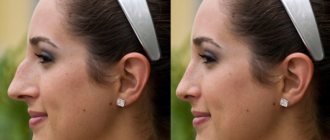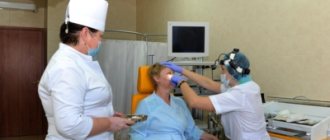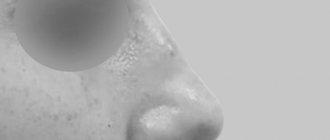More about the operation
Nasal fractures account for almost 40% of the total number of facial injuries.
The causes of damage can be a traffic accident, a fall, household injuries, some sports, etc. Repositioning is a surgical procedure aimed at restoring the functionality and anatomy of the nose. The doctor compares bone fragments in an anatomically correct position, helping them to heal faster. The method of surgical intervention depends on the type of injury and its severity. Restoring the shape of the organ is carried out in the following ways:
- finger – used when it is necessary to eliminate lateral deformation. The doctor presses with his fingers on the area of asymmetry until there is a click, which is evidence that the bones are in place. A control x-ray examination is performed both before and after the manipulation;
- instrumental - performed using special instruments (Volkov elevators), which the surgeon inserts into the nasal canals and lifts bone fragments with them, restoring the shape of the organ. A control x-ray examination is performed both before and after the manipulation;
- finger-instrumental – is carried out in the presence of retraction of the back of the nose and displacement of the bones to the side. The otolaryngologist expands the nasal passages with special dilators, returning the displaced fragments to their place and fixes them in their normal position with dense turundas (anterior nasal tamponade), which simultaneously perform a hemostatic function. A control x-ray examination is performed both before and after the manipulation.
In cases of severe open fractures or fractures of all lateral cartilages, open reconstruction of the nasal skeleton is used. This is a full-fledged operation that involves cutting tissue, comparing bone fragments under visual control, and applying sutures. To fix the fragments put in place, tamponade, special plate devices, metal, plastic or plaster splints, etc. can be used.
Rhinoplasty of nasal hump
In case of incorrect actions after a nose fracture, a hump may form after a certain time. It is also possible to get rid of this nasal deformity during surgery to correct the consequences of a fracture.
Attention! Even if you had a hump or crooked nose before the fracture, it can be corrected during surgery. Discuss all the details with the operating doctor, and perhaps you will immediately correct all the imperfections of the nose.
The operation is performed under general anesthesia and lasts up to three hours. Hump rhinoplasty is performed as follows:
- First of all, the doctor cuts the skin on the inner surface of the wings of the nose:
- then the hump itself is removed;
- the position of the bones and volume in this area are corrected;
- stitches and a bandage are applied, and turundas are placed in the nostrils.
Please note that this correction may make your nose appear longer.
Therefore, additional correction of the tip of the nose is possible, thus:
- access to cartilage tissue is provided;
- certain lobes are excised;
- if necessary, install a support;
- cartilages are sewn together;
- a cosmetic suture is applied
Cost of repositioning nasal bones for fractures
The prices indicated in the price list may differ from the actual prices. Please check the current cost by calling +7 495 104 8605 (24 hours a day) or at the GMS Hospital clinic at the address: Moscow, st. Kalanchevskaya, 45.
| Name | Common price | Price with 30% discount |
| Closed reduction of the nasal bones | 58,000 rub. | 40,600 rub. |
| Reposition of a closed fracture of the nasal bones with PSO wound | RUB 52,715 | RUB 36,901 |
| Reposition of an open fracture of the nasal bones with PSO wound | 100,000 rub. | 70,000 rub. |
| Reposition of bone fragments in a closed fracture | RUB 25,835 | RUB 18,085 |
Prices for the most popular services are indicated with a 30% discount, which is valid when paying in cash or by credit card. You can be served under a VHI policy, pay separately for each visit, sign an agreement for an annual medical program, or make a deposit and receive services at a discount. On weekends and holidays, the clinic reserves the right to charge additional payments according to the current price list. Services are provided on the basis of a concluded contract.
Plastic cards MasterCard, VISA, Maestro, MIR are accepted for payment. Contactless payment with Apple Pay, Google Pay and Android Pay cards is also available.
Make an appointment We will be happy to answer any questions Coordinator Oksana
Why surgery is needed
If reduction is not carried out in a timely manner, serious complications may arise. The most common of them is a deviated nasal septum, which causes:
- disturbances of normal nasal breathing;
- constant inflammation of the mucous membrane and paranasal sinuses (chronic rhinitis, sinusitis);
- disorder of smell perception, up to complete anosmia.
Another common complication is a hematoma of the nasal septum, which in turn leads to narrowing of the nasal canals, difficulty breathing, and in some cases, suppuration or melting of the cartilage.
You need to understand that not a single untreated fracture goes away without a trace. Timely reposition allows not only to avoid such problems, but also to do without subsequent plastic surgery. The intervention lasts only a few minutes, does not require hospitalization, and postoperative recovery is about 2 weeks.
Advantages of nasal bone repositioning at GMS Hospital
Experienced otolaryngologists at GMS Hospital perform all types of repositioning of nasal bones in case of a fracture. In our surgical center, such manipulations are carried out using minimally invasive methods, which eliminates surgical scars and scars.
A team of highly specialized specialists works on each clinical situation, which allows us to evaluate it from all sides and select the most optimal method of therapy. And the use of modern diagnostic equipment makes it possible to reliably determine the extent of damage to soft and hard tissues and carry out the procedure with precision.
The manipulation is performed within an hour if there are no contraindications (no severe swelling, concussion, etc.). The surgery center of the GMS clinic operates 24 hours a day. An appointment with an ENT surgeon can be made by phone or online.
Leading doctors
- Zavarzin Boris Alexandrovich
Operating otolaryngologist. Candidate of Medical Sciences
Danube Ave., 47
- Zaichenko Vladislav Sergeevich
Operating otolaryngologist, head of the ENT department
Udarnikov Ave., 19
- Lutsevich Andrey Ivanovich
Operating otolaryngologist. Doctor of the first category
Udarnikov Ave., 19
- Mishkorez Maria Vladimirovna
Operating otolaryngologist
Vyborg highway, 17-1
- Astakhov Anatoly Petrovich
Udarnikov Ave., 19, Danube Ave., 47
- Daliev Bakhodir Bakhtierovich
Otolaryngologist
st. Marshala Zakharova, 20
- Isaev Badri Isaevich
Operating otolaryngologist
Danube Ave., 47
- Miniakhmetova Regina Rimovna
Otolaryngologist
st. Marshala Zakharova, 20
- Mikhailova Ekaterina Andreevna
Otolaryngologist
Danube Ave., 47
- Negazov Alexander Alexandrovich
Operating otolaryngologist
Vyborg highway, 17-1
- Sergeev (Sleptsov) Alexey Vladimirovich
Operating otolaryngologist
Danube Ave., 47
View all
- Karpuschenko Maxim Alekseevich
Dunaysky Ave., 47 - Sharafiev Gleb Ildarovich
Udarnikov Ave., 19
- Guseinov Eduard Gasanovich
Danube Ave., 47
- Zaichenko Sergey Sergeevich
Udarnikov Ave., 19
- Solovyov Alexander Vladimirovich
Vyborg highway, 17-1
- Vyaznikov Dmitry Andreevich
Vyborg highway, 17-1
- Kononenko Evgeniy Igorevich
Danube Ave., 47
- Kucherova Marina Vladimirovna
Vyborg highway, 17-1
- Nirsha Larisa Vasilievna
Vyborg highway, 17-1
- Ostanina Yulia Viktorovna
Vyborg highway, 17-1
- Ponidelko Sergey Nikolaevich
Danube Ave., 47
- Savin Maxim Sergeevich
st. Marshala Zakharova, 20
- Titriku Rowland Elikem
st. Marshala Zakharova, 20
- Khabibov Mamed Suleymanovich
Vyborg highway, 17-1
Hide
Indications for surgery
Direct indications for surgical manipulation are:
- closed fractures of the nose - the outer integument is not damaged or the damage is expressed by superficial abrasions;
- open fractures, with damage to superficial tissues and bone fragments in the wound;
- fractures with displacement (there is a pronounced deformation of the nasal skeleton, disrupting the asymmetry of the face).
Fractures are often confused with severe bruises. But there are several signs that unconditionally indicate serious organ injury:
- nosebleeds (external, internal);
- pain around the nose, the intensity of which increases when trying to feel the site of injury;
- swelling of the mucous membrane and soft tissues, leading to difficulties with nasal breathing;
- visible change in the shape of the organ (retraction of the back, pressing inward, displacement to the side);
- crepitus of bone fragments (a characteristic crunch is heard when trying to feel the organ) - this symptom is checked only by specialists, otherwise serious damage can be caused.
If you are injured and have even one of the above symptoms, do not delay, go to the doctor immediately.
Dangerous moment
Noses are broken not only in fistfights, but also during ordinary games, in which one person can accidentally shine an elbow, a ball or a puck in the face of another. Unsuccessful falls, for example, from stairs, roller skates or a bicycle, often lead to this injury. In winter, the sled of a friend who couldn’t wait to ride down the hill after his friend can be “imprinted” right on a child’s nose. Children who did not listen well to the life safety teacher and came too close to the swinging swing also had their noses broken. Hyperactive children and inattentive adults who do not look at their feet run the risk of slipping and hitting the most prominent part of their face on a curb or stone, and at home, on the side of a bathtub or sink. In general, none of the children and adults are guaranteed against such trouble.
Preparation, diagnostics
Although the reduction of the bones of the nasal skeleton is an outpatient procedure, it is necessary to prepare for it in advance. Diagnostic measures are aimed at clarifying the nature, type and degree of the fracture, as well as identifying other disorders. Preoperative preparation includes:
- X-ray of the nose and paranasal sinuses;
- rhinoscopy;
- CT, MRI of the skull;
- blood and urine tests;
- consultation with an anesthesiologist.
The procedure is carried out in the first few hours after the injury, before tissue swelling occurs, or after 2-5 days, when the swelling subsides.
If more than 10 days have passed after the injury, it will be much more difficult to realign the nose, and after 3 weeks a callus will begin to form at the fracture site and repositioning can only be done with a complex operation. Therefore, it is extremely important to seek qualified help in a timely manner. An experienced surgeon will perform the procedure according to indications quickly and with minimal discomfort. After a short time, nothing will remind you of the trauma you suffered.
How is the operation performed?
Reduction of the bones of the nasal skeleton is performed in an outpatient operating room using local anesthesia. No hospitalization required. The reduction technique is selected individually, depending on the type of fracture. For closed fractures with bones displaced to the side, the finger method is used - the surgeon presses with his thumbs on the deformed area until a characteristic click is heard, indicating that the fragments have moved into place.
In case of injuries accompanied by retraction of the nasal bridge, reposition is carried out using special instruments. The doctor inserts them into the nasal canals, lifting the displaced bones and returning them to their place. Next, fixes the fragments in the desired position with dense tampons.
For mixed injuries, simultaneously accompanied by displacement of the bones to the side and retraction of the nasal dorsum, the finger-instrumental method is used. If necessary, for better fixation of bone fragments, anterior tamponade is supplemented by applying a pressure bandage or plaster splint to the nose.
Open fractures have their own characteristics. Since in these cases there is damage to the skin and soft tissues, the doctor first treats the wound with an antiseptic and only then restores the nasal skeleton. GMS Hospital specialists try to preserve all bone fragments, even the smallest ones, during the intervention. This makes it possible to restore the anatomical shape of the organ as much as possible. The procedure ends with suturing. If the wound is dirty or inflamed, additional treatment is prescribed.
Reposition lasts 10-40 minutes (depending on the nature of the fracture and the extent of the intervention); after the manipulation, the patient can immediately go home. However, in the presence of heavy or recurrent bleeding, severe deformation of the nasal skeleton and injuries complicated by infection or inflammation, hospitalization is required.
You have questions? We will be happy to answer any questions Coordinator Tatyana
Types of reposition and methods of implementation
The type of reposition and tactics for its implementation are chosen by the ENT doctor based on the nature and severity of the injury.
If the fracture is open, the doctor first treats the wound with hydrogen peroxide or another antiseptic. Then he administers anesthesia and performs the operation itself, inserting bone fragments into place. If there is no inflammation, the doctor applies stitches. If there is pus or contamination in the wound, then the wound is not temporarily sutured and is treated with open access, in order to better sanitation of the wound. After surgery for an open fracture, the patient is prescribed a course of antibiotics and the use of regenerating ointments and antiseptic drugs.
Closed reduction is most often performed manually using local anesthesia. It happens that a couple of skillful movements with your fingers are enough for the bones to fall into place. If displacement occurs, the ENT doctor uses elevators. Afterwards, special tight cotton swabs are inserted into the nasal passages, fixing the bones and providing a reliable frame from the inside.
In certain cases, with severe deviation and mobility, a special plaster cast is applied to the wings of the nose to prevent displacement of the bones, as well as to speed up the process of their fusion. This plaster cast is worn for one to two weeks. It is noteworthy that as the swelling subsides, the bandage begins to “dangle” on the face, and it needs to be replaced with a new one, giving it new shapes.
Usually, after the operation, the patient is sent home. Observation in a hospital is prescribed if the bleeding does not stop or in case of very severe fractures.
Features of the rehabilitation period
For several days after the intervention, minor pain may occur, which is eliminated with painkillers prescribed by the surgeon. Fixing tampons are removed from the nasal passages after 3-4 days, the plaster is removed 7-14 days after the intervention.
Recovery time depends on the extent of the intervention and the nature of the injury. On average, the recovery period lasts from 3 to 6 weeks. All this time you need to adhere to the following recommendations:
- any load on the organ is eliminated - you cannot wear glasses, sleep on your side or stomach, or touch your nose with your hands from the outside or inside;
- sports and physical activity should be postponed until recovery;
- Any thermal exposure is prohibited - hot baths, visits to saunas, solariums, beaches, baths must be excluded;
- avoiding alcohol, spicy and hot food and drink - this increases blood circulation and can cause bleeding.
Final fusion of the bones usually occurs 2-3 months after the injury.

